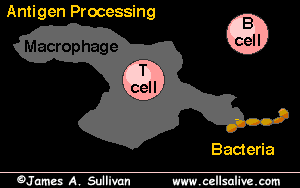How Lymphocytes Produce Antibody
 The scanning electron micrograph (right) shows a human macrophage (gray) approaching a chain of Streptococcus pyogenes (yellow). Riding atop the macrophage is a spherical lymphocyte. Both macrophages and lymphocytes can be found near an infection, and the interaction between these cells is important in eliminating infection. Below is an animation that illustrates the basic cell-cell interactions that lead to antibody production can be seen in the accompanying animation.
The scanning electron micrograph (right) shows a human macrophage (gray) approaching a chain of Streptococcus pyogenes (yellow). Riding atop the macrophage is a spherical lymphocyte. Both macrophages and lymphocytes can be found near an infection, and the interaction between these cells is important in eliminating infection. Below is an animation that illustrates the basic cell-cell interactions that lead to antibody production can be seen in the accompanying animation.
 Antigen Processing
Antigen Processing
When the macrophage eats bacteria, proteins (antigens) from the bacteria are broken down into short peptide chains and those peptides are then "displayed" on the macrophage surface attached to special molecules called MHC II (for Major Histocompatibility Complex Class II). Bacterial peptides are similarly processed and displayed on MHC II molecules on the surface of B lymphocytes.
Helper T Cell Stimulating B Cell
When a T lymphocyte "sees" the same peptide on the macrophage and on the B cell, the T cell stimulates the B cell to turn on antibody production. The helper t cell stimulates b cells through the release of cytokines.
Antibody Production
The stimulated B cell undergoes repeated cell divisions, enlargement and differentiation to form a clone of antibody secreting plasma cells. Hence. through specific antigen recognition of the invader, clonal expansion and B cell differentiation you acquire an effective number of plasma cells all secreting the same needed antibody. That antibody then binds to the bacteria making them easier to ingest by white cells. Antibody combined with a plasma component called "complement" may also kill the bacteria directly.
Monoclonal Antibodies
Using this knowledge scientists can now make large amounts of specific monoclonal antibodies for both antigen detection and treatment of diseases.
